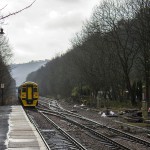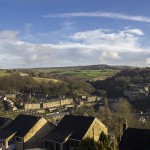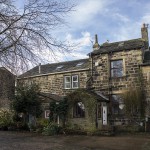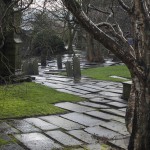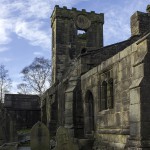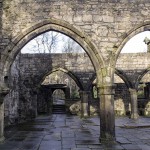A friend and I visited Manchester on the second week of January and one day we got on the train and went to Hebden Bridge. It’s a town just 30 minutes from Manchester and the landscape changed quite a bit on the way. We were also surprised by a long tunnel, till then we found the land rather flat with a few hills. When we got to the train station it was sunny with a blue sky, while we got our tickets the sky turned dark grey with heavy rain. It was still raining until the tunnel; after we emerged the sky was blue again with sunshine. We were a bit worried that it would rain the whole time during our train ride.
Eine Freundin und ich waren die zweite Januarwoche in Manchester und an einem Tag fuhren wir mit dem Zug nach Hebden Bridge. Der Ort liegt ca. 30 Minuten von Manchester entfernt und die Landschaft änderte sich auf der Fahrt doch ein wenig. Auch waren wir überrascht durch einen langen Tunnel zu fahren, uns kam das Land bis dahin flach mit einigen Hügeln vor. Als wir zum Bahnhof liefen war es sonnig mit blauem Himmel, während wir die Tickets holten färbte sich der Himmel dunkel und es regnete auf einmal heftig. Während der Fahrt begleitete uns der Regen, nachdem wir aus dem Tunnel kamen schien jedoch wieder die Sonne und der Himmel war blau. Während der Zugfahrt waren wir schon leicht besorgt, dass es die ganze Zeit regnen würde.
Hebden Bridge
Of course we have read the news about the torrential rain and the flooded areas in north England, what we didn’t take in consideration for our trip was that Hebden Bridge was in the north of Manchester and lies between two rivers. When we got to the tourist information the whole room was nearly empty all around stood radiators and dryiers, in the middle of it at a table with maps of Hebden Bridge sat the employee, we felt so sorry for her. At first we didn’t really notice the aftermath of the flood (which was just 11 days ago), because people have been already so busy that of course you could still see sand sacks, but else it looked busy and really good. Okay, some cafés were still closed, the walkabouts were also still too muddy, so she advised us to go to Heptonstall.
Natürlich hatten wir von der Überflutung und den Dauerregnen im Norden Englands gehört. Was wir jedoch nicht bedacht hatten war das Hebden Bridge, nördlich von Manchester, zwischen zwei Flüssen liegt. Als wir zur Touristen-Information kamen war der Raum fast leer und trocknete, es standen überall Heißkörper und Entfeuchter, in der Mitte saß die Angestellte an einem Tisch mit einer Karte von Hebden Bridge. Sie tat uns so leid. Wir hatten die Nachwehen der überfluteten Straßen erst gar nicht bemerkt (was gerade mal 11 Tage her war), weil die Leute schon so fleißig waren, natürlich sah man noch Sandsäcke hie und da liegen aber der Rest sah geschäftig und okay aus. Gut einige Cafés hatten noch geschlossen, die Rundgänge waren auch noch zu matschig, so dass sie uns riet den Weg nach Heptonstall zu nehmen.
Footpath to Heptonstall and Cross Lanes Methodist Graveyard
Since the water level was still pretty high we went up to Heptonstall. A footpath led the way… and what a steep path that was; we were not prepared for that! Still, we got a lovely view, some breaks with cookies helped a lot too. Before we came to Heptonstall we found a tiny old graveyard, that needs much caring. The tombstones were all crooked and some were fallen down.
Da der Wasserstand immer noch recht hoch war gingen wir hinauf nach Heptonstall. Ein Fußweg führte hinauf… und der war ganz schön steil, darauf waren wir nun wirklich nicht vorbereitet gewesen. Wir hatten aber eine super Aussicht und Pausen mit Keksen halfen ungemein. Bevor wir Heptonstall erreichten kamen wir an einem kleinen alten Friedhof vorbei, der durchaus etwas Pflege bedarf. Die Grabsteine standen schief und einige waren bereits umgefallen.
Heptonstall
At last we arrived. And what a beautiful place it is with narrow pathways, old houses, a lovely view and some interesting churches. It felt like stepping back in time. Heptonstall was once a village of weavers and the centre of the village hasn’t changed much. It’s really just a small village atop a hill, but still full of history.
The old Cloth Hall is now a monument to the former importance of the local cloth trade. It was built during 1545-1558 and used as a market hall for the sale of the finished work. It is the oldest town cloth hall in Yorkshire.
There is also an old stone archway that dates back to 1578 and marked the entrance to Whitehall Farm. It was originally named “Bentley’s” or “Bentley Land” from the family. The most famous of the family was Dr. Richard Bentley (1662-1742), who was said to be the most brilliant classical scholar of his age.
Then we have the old Grammar School, right next to the churchyard, which houses now a small museum.
Am Ende haben wir Heptonstall erreicht. Ein hübscher Ort mit schmalen Gassen, alten Häusern, einer wunderschönen Aussicht und einigen interessanten Kirchen. Es war als gehe man zurück in die Vergangenheit. Heptonstall was einmal ein Weberdorf und der Dorfkern hat sich kaum verändert. Es ist wirklich nur ein kleines Örtchen auf einem Hügel, aber dennoch voll mit Geschichte.
Da haben wir zum einen das Gewandhaus (Cloth Hall), welches jetzt als Denkmal für die frühere Bedeutung des örtlichen Tuchhandels dient. Das Gebäude wurde zwischen 1545 und 1558 gebaut und diente als Markthalle für den Handel der fertigen Stoffe. Es ist die älteste Tuchhalle in Yorkshire.
Dann gibt es noch einen alten steinernen Bogen, der zurückgeht auf 1578 und den Eingang zur Whitehall Farm markiert. Die Farm war früher bekannt unter den Namen „Bentley’s“ oder „Bentley Land“ nach den Namen der Familie. Ein berühmtes Familienmitglied war Dr. Richard Bentley (1662-1742), der zu seiner Zeit als der größte Gelehrte der Klassik zählte.
Gleich neben den Kirchplatz gibt es die alte Grammatikschule, in welchem sich jetzt ein kleines Museum befindet.
St. Thomas à Becket Church and old churchyard
Really, really worth a visit for anyone who loves old and interesting graveyards and a good ruin. Lovely place. I know it’s a church ruin, but still, the whole place has so much charm and history it was fantastic. It is quite unique to find two churches in one churchyard. Especially since the old church was damaged severely by a storm in 1847 and was neither removed nor restored but left to become a ruin. Instead it was decided to build a new church right next to the old one.
The ruin is a fine example of former architecture. The oldest parts of the church date back to the mid 1200s and were built with local gritstone. The south aisle and chancel are from the 15th century and the north chancel and north outer aisle are from the 16th century. One can see the different building periods when looking at the windows. It changed a lot over the centuries with the changes in belief. At the end there was seating for 815 people on the ground floor and 300 in the upper floor. This shows the wealth and determination of the people and the large population.
The graveyard is also very interesting, and we noticed that a lot of the people buried in the 17th century were over 80 years old…
Wenn man sich für alte, interessante Friedhöfe und einer guten Ruine interessiert ist es wahrhaftig einen Besuch wert. Wunderbarer Ort. Ich weiß es ist eine Kirchenruine, aber dennoch besitzt der gesamte Ort so viel Charme und Geschichte, dass es wunderbar ist. Es ist recht einzigartig auf einem Kirchplatz zwei Kirchen zu finden. Besonders da die alte Kirche 1847 durch einen Sturm schwer beschädigt wurde und weder abgetragen noch wieder aufgebaut wurde, sondern zur Ruine wurde. Stattdessen entschied man sich einfach eine neue Kirche neben die alte zu bauen.
Die Ruine ist ein schönes Exemplar für die damalige Architektur. Die ältesten Teile der Kirche wurden aus dem örtlichen groben Sandstein in der Mitte 1200 erbaut. Das südliche Seitenschiff und die Kanzel sind aus dem 15. Jahrhundert und die nördliche Kanzel sowie das äußere Seitenschiff aus dem 16. Jahrhundert. Man kann z.B. anhand der Fenster die unterschiedlichen Bauphasen erkennen. Der Baustil änderte sich im Laufe der Zeit mit den Veränderungen des Glaubens. Am Ende fanden 815 Menschen im Erdgeschoss Platz und nochmals 300 in der oberen Etage. Dies zeigt den Reichtum und den Ehrgeiz der Leute an sowie die große Einwohnerzahl.
Ebenfalls sehr interessant ist der umliegende Friedhof. Wir bemerkten, dass viele Menschen, die hier begraben liegen über 80 Jahre wurde und das im 17. Jahrhundert…
19th century church of St. Thomas the Apostle
The new church was completed in 1854 in the Gothic Revival style. I can’t really say much about the new church, we didn’t go inside, we just went around it, since the ruin is so much more fascinating.
Die neue Kirche wurde 1854 im neugotischen Stil fertig gestellt. Ich kann nicht wirklich viel über die neue Kirche sagen, da wir nicht hinein- sondern nur herumgingen. Die Ruine war einfach viel faszinierender.
Heptonstall Methodist Chapel
We had planned to visit the octagonal Methodist Church before going to the other church, but we missed the sign showing the way. So, on our way we went looking for it. Here it is, a small octagonal church that was built in 1764 by John Wesley. There are two versions why it was designed octagonal; on the one hand it was supposed to look different from the other churches, on the other hand so the devil has no corners in which to hide. The information inside the church says that it is the oldest Methodist Church in continuous use. There is also a note asking the visitor to close the door, so no cat could slip in, a very practical tip 😉
Wir hatten eigentlich geplant die achteckige Methodistenkirche zuerst zu besuchen, aber haben das Schild übersehen, dass den Weg wies. Also versuchten wir es nochmals auf dem Rückweg. Hier ist sie, die achteckige Kirche, die 1764 John Wesley erbauen ließ. Es gibt zwei Varianten weshalb sie acht Ecken hat. Die eine besagt, dass sich das Gebäude von anderen Kirchen abheben sollte, die andere dass der Teufel keine Ecke finden sollte in der er sich verstecken kann. Auf Infotafeln in der Kirche stand auch, dass es sich hier um die älteste durchgängig genutzte Methodistenkirche. Weiterhin stand auf einer Notiz, dass man bitte die Tür schließen soll, so dass keine Katzen hineinhuschen können. Überaus praktischer Hinweis 😉
All in all we can say it is worth a visit and we’ll come back to Hebnden Bridge and Heptonstall in summer or autumn. The countryside is really wonderful.
Ingesamt können wir sagen, dass es einen Besuch wert ist und wir im Sommer oder Herbst nochmals nach Hebden Bridge and Heptonstall kommen werden. Das umliegende Land ist wirklich wunderschön.



